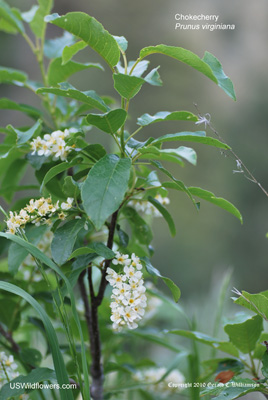Wildflowers of the United States | |||||||||||||
| |||||||||||||
Prunus virginiana - Chokecherry, Western Chokecherry, Black Chokecherry. There are three varieties of Prunus virginiana in the United States - P. Virginia var. virginiana (Common Chokecherry) is found in the eastern part of the country, and both P. virginiana var. melanocarpa (Black Chokecherry) and P. virginiana var. demissa (Western Chokecherry) are found in the western part. One variety or another is found in every state except Louisiana, Alabana, Mississippi, Florida, South Carolina, and Hawaii. Chokecherry is also found in most Canadian provinces. | There are minor differences between the varieties. Among other differences, var. melanocarpa has black fruit while the others have red or purple fruit. The fruit is edible, but use caution – as with many drupes (fruits with skin, pulp, and hard middle seed) the pit can be poisonous if consumed in large enough quantities (note that this is also true of peach, cherry, and plum pits,) and children have reportedly died from eating a large quantity of chokecherries with pits. My initial identification of this plant was made using Idaho Mountain Wildflowers Although it is a useful wildlife food, it is considered weedy or invasive in the Northeast by some authorities, so use some discrimination in determining whether to propagate the plant. Leave comments on Prunus virginiana at this link.   Blue=Native; Grey=Introduced Map from USDA Plants Database: USDA, NRCS. 2017. The PLANTS Database (http://plants.usda.gov, 08 May 2025). National Plant Data Team, Greensboro, NC 27401-4901 USA. Search Our Database: Enter any portion of the Scientific, Common Name, or both. Do a general Google search of the entire site: #ad
|
| #ad
| | |||||||||
|
Commercial / Cookie Notice Looking for Wildflowers for a specific state? Check here: | |||||||||||||
|
| |||||||||||||


